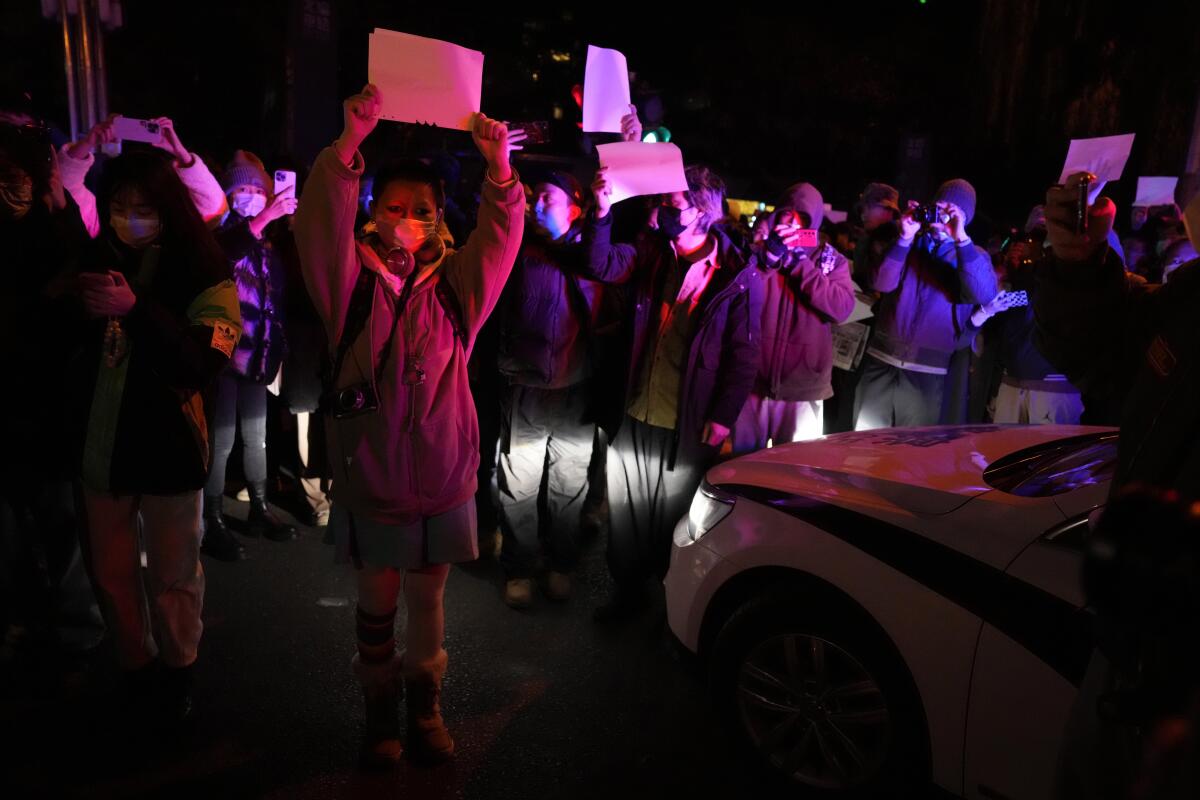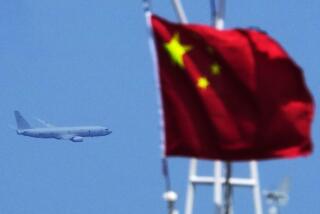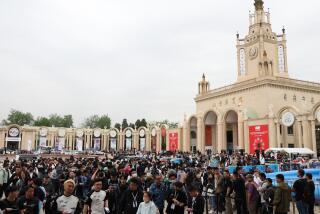White House watches cautiously as protests over COVID restrictions roil China

- Share via
WASHINGTON — The Biden administration is treading lightly in response to demonstrations in China by citizens angry over the country’s harsh COVID-19 restrictions, drawing criticism from Republicans and democracy advocates who say the White House should act more forcefully.
The protests, which broke out across China over the weekend, were triggered by the deaths of 10 people in an apartment building fire in the country’s far west last week. Residents blamed China’s strict “zero-COVID” strategy, which includes shutdowns of entire cities and towns when coronavirus cases are detected, for trapping people in their rooms and slowing the ability of firefighters to respond.
Public protests are extremely rare in China and have excited human rights and democracy advocates searching for any signs that President Xi Jinping is losing his grip on power. But so far, most outside analysts and foreign policy experts have cautioned that Xi will probably be able to contain the demonstrations in short order.
Relations between Washington and Beijing were extraordinarily tense even before the protests, and the Biden administration may be reluctant to condemn Xi after the presidents met in person for what U.S. officials described as a positive interaction just two weeks ago. U.S. officials are hoping that encounter could slow the decline in the two countries’ relations, and worry that condemning Xi could jeopardize any progress.
“The White House supports the right of peaceful protest … around the world,” National Security Council spokesman John F. Kirby said Monday. “People should be allowed the right to assemble and peacefully protest policies or laws.”
He stopped short, however, of criticizing Beijing’s heavy-handed efforts to crack down on demonstrations. He and other White House officials did express skepticism over China’s “zero-COVID strategy” and whether it would ultimately succeed in stopping the spread of the disease in the country where it was first detected.
“We’re watching this closely as you might expect that we would,” Kirby said.
Critics in the GOP and other conservative circles accused the administration of failing to act forcefully to take advantage of a potentially pivotal moment.
“Pitiful,” tweeted Sen. Ted Cruz (R-Texas). “At a potentially historic inflection point, Dems shill for the CCP [Chinese Communist Party]. “It’s almost as if Biden wishes he was driving a tank in Tiananmen Square….”
Sen. Marco Rubio (R-Fla.) and Rep. Christopher H. Smith (R-N.J.) said the administration’s reaction to the protests is “nothing short of cowardly” and accused President Biden of failing to “stand up to the CCP and stand in solidarity with the Chinese people.”
Western governments should do far more to support the protesters, including issuing “unequivocal and specific warnings to China about the consequences of any bloody crackdown,” Jianli Yang, a former Tiananmen Square protester, wrote in a Monday op-ed published in the Washington Post.
Human Rights Watch, an international advocacy organization, advised all governments speaking about the unrest in China to go further than the Biden administration has so far — to not only “express support for people’s rights to free speech and assembly,” as the White House did, but also “urge the Chinese authorities not to suppress the protests,” which it did not.
But groups of Chinese people “shouting on a road in Shanghai,” where some went so far as to demand that Xi step down, and the other rallies do not a revolution make, said Robert Daly, a former U.S. diplomat in China who now heads the Kissinger Institute on China at the Wilson Center think tank.
“People are eager to see echoes of Tiananmen,” Daly said, referring to the 1989 pro-democracy protests in the Beijing square and subsequent crackdown, “but I don’t see it. There is national discontent with the prices of COVID. But this is not a national movement.”
The demonstrations are overwhelmingly the product of pandemic-related restrictions that have, for periods, kept millions of people confined to home, banned from travel, unable to work. Ending those practices is the one unifying demand of the wave of protests.
“When demonstrators say, ‘No to [COVID-19] tests, we want freedom,’ they are not talking about Bill of Rights freedom,” Daly said. “They are talking about returning to the kinds of freedom of movement they had” before the pandemic.
In a written analysis, Craig Singleton, a senior fellow specializing in China at the Foundation for Defense of Democracies, agreed that the protests were unlikely to “seriously challenge” the authority of the Communist Party even though the “tenuous trust” between party and people is “starting to fray.”
Daly and other analysts said Xi will probably be able to manage the current crisis with some cosmetic adjustments to the COVID-19 policies or local measures that would ease pressure in limited areas, in addition to increased repression to isolate protest outbreaks and detain instigators.
The crescendo of protests now is due in part to expectations among many Chinese that COVID-19 restrictions were going to be eased after the 20th Communist Party conference in which Xi cemented his unprecedented third term as the country’s leader. But a spate of new cases brought additional lockdowns instead.
Some experts cautioned that if the Biden administration were to lend full-throated support to demonstrators, the Xi government would then brand U.S. officials as instruments of outside forces attempting to destabilize China, a frequent trope used by Beijing to discredit dissidents.
Xi has a “remarkable repertoire to crack down and [exert] control,” said Carla Freeman, a veteran China expert at the U.S. Institute of Peace. These include “mild-mannered” tactics such as having police seize and erase photos from the phones of demonstrators, and the more drastic measure of moving riot-gear security agents into position near rally sites.
“He will ease restrictions where possible, crack down where needed and manage where he can” with tactics from subtle intimidation to violence, Freeman said.
On Monday, the Chinese government appeared to already be moving aggressively to crush the protest movement. Few demonstrations were reported that day, but social media posts described numerous arrests.
More to Read
Get the L.A. Times Politics newsletter
Deeply reported insights into legislation, politics and policy from Sacramento, Washington and beyond. In your inbox three times per week.
You may occasionally receive promotional content from the Los Angeles Times.











